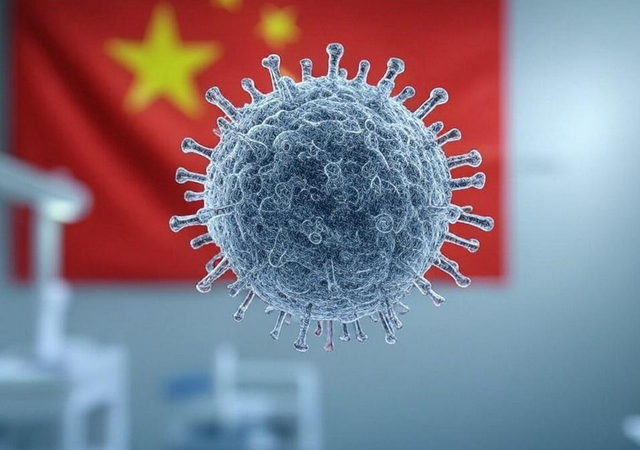Trump’s Tariff War Exposes China’s Hidden Fragilities
“Xi Jinping may soon face a third of his export factory workforce unemployed—in a society that has no mechanism for them to vent tensions and objections peacefully.”

Trade wars are tough. They disrupt the status quo, drive up prices in the short term, strain supply chains, and inject uncertainty into the economy.
But they can also serve a larger strategic purpose.
By recalibrating trade relationships and reducing our overreliance on China, this conflict could lay the foundation for a more balanced and resilient global economy. It won’t be painless—but if managed wisely, the long-term gains may well outweigh the short-term costs.
China has several tools at its disposal to retaliate against the U.S. It has already taken steps to restrict the export of critical rare earth minerals and has attempted to rally support among allies and neighboring nations.
But as the junior power in the U.S.–China relationship, and as the surplus nation whose economic rise has been fueled in part by intellectual property theft and other coercive practices, China also faces significant vulnerabilities.
And, as I wrote last week, they’re already contending with serious internal problems.
White House National Economic Council Director Kevin Hassett reported on Monday that the Trump administration is currently engaged in trade negotiations with representatives from 130 nations. “We’ve got everybody in the trade team and even deputies of people in the trade team talking to just about everybody on Earth, and I think that we’ve got more than 10 deals where there’s very good, amazing offers made to the U.S.,” he said. That is good news, indeed.
In a Monday op-ed, historian and conservative commentator Victor Davis Hanson made the case that China will lose the trade war with the U.S. and that it would happen “gradually, then suddenly.” When nations are forced “to choose between a rogue economic actor and a flawed but fairer partner with unmatched global power,” they are far more likely to choose the U.S.
Hanson concedes that China can inflict short-term damage on the U.S., particularly through a halt in exports of pharmaceuticals or rare earth minerals.
If China really does reduce most of its exports to the U.S., America will have to scramble for a year or so to establish new supply chains and some alternate importers of U.S. products. But after a year of gradual dislocation, China will begin to hemorrhage, and then quite suddenly, given the U.S. has almost all the advantages—if it chooses to use them.
…
Consensual societies are far more flexible in dealing with external pressures and volatile public opinion. True, Trump must face a midterm election in 18 months. However, Xi Jinping may soon face a third of his export factory workforce unemployed—in a society that has no mechanism for them to vent tensions and objections peacefully.
He notes that “China is running a nearly $1-trillion trade surplus with the world” which is the result of its “market manipulations, product dumping, asymmetrical tariffs, patent, copyright and technology theft, a corrupt Chinese judicial system, and Western laxity—or what might be mildly called ‘bullying.'” This will make it difficult for China to claim “victimhood when tariffs and surpluses illustrate contrived trade aggression.”
Hanson essentially concludes that most countries have caught on to China, which, in his words, “has done everything possible to incur global distrust and fear.” The Chinese Communist Party’s refusal to take responsibility for unleashing COVID-19 on the world spoke volumes.
In sum, if the Trump administration can conclude first-round—good enough but not yet perfect— trade deals in the next few weeks with major EU countries, Japan, and other Asian and Pacific powerhouses, and then redirect to China, it will gain both political support and economic advantage. It also must message strategically, given that China, for a half-century, has waged a quiet trade war that has now birthed a loud reaction. So, the administration must remember that the current status quo is the aberration, and its correction is a return to normalcy.
In the end, the EU and Asian nations should know the difference between their protective and rules-based ally, with whom they have run up huge and unfair surpluses, and a rogue bully, whose flagrant violations of trade norms and unfair tariffs have ensured them large trade deficits. And if they don’t calibrate their economic self-interest, but act emotionally, then they should at least consider realpolitik facts, such as which nation has the larger economy, the more open political system, and the largest and most lethal military that, in extremis, would come to their aid—against a bullying China.
I highly recommend reading the entire article.
Beyond China’s current economic troubles and Trump’s newly declared tariff war, the authoritarian state faces a deeper, more intractable challenge—one that no amount of control can resolve. A similar obstacle, in fact, was what toppled Japan from its economic heights in the 1990s.
Those of us of a certain age recall that during the 1980s and early 1990s, Japan’s economy was on fire. Japanese cars and electronics flooded the U.S. market—I myself drove a Datsun at the time, a Nissan brand that was phased out in 1986. Around the world, companies scrambled to emulate Japan’s “just-in-time” or “lean” manufacturing practices, where production matched demand with remarkable precision. Japan was riding high, and many Americans believed it was only a matter of time before it surpassed us.
In a Monday op-ed titled The End of the Chinese Dream, Chinese demographer, author, and activist Yi Fuxian noted that due to a young population and a rapidly growing workforce, “Japan’s GDP grew from a mere 9% of US GDP in 1960 to 73% in 1995, and its per capita GDP grew from 17% of America’s to 154% in the same period.” Additionally, just as we consider China to be our “chief rival” today, a 1989 poll found that, by a 3-to-1 margin, Americans worried more about the economic threat posed by Japan than the military threat posed by the Soviet Union.
But as we all know, it didn’t work out that way. As the Samurai Nation learned the hard way, demographics matter. Yi pointed out that when Japan’s ratio of working age people to those over 65 years old fell below that of the U.S. in the early 1990s, Japan’s GDP growth rate began to slow. Yi explained, “Its prime-age labor force … has been declining since 1995, whereas America’s will continue to grow throughout this century. As of 2024, Japan’s GDP had fallen to just 14.5% that of the US, and its per capita GDP had fallen to 38% of the US level.”
Yi emphasized that while comparisons to 1990s Japan are frequent, China faces an even bleaker future because its fertility rate (children per woman) is even lower than Japan’s. “In 2000, 2010, and 2022, Japan’s fertility rate … was 1.36, 1.39, and 1.26, respectively, whereas China’s was only 1.22, 1.18, and 1.05.. China is now struggling to stabilize its fertility rate at a meager 0.8 — less than half the “replacement rate” (2.1). Its prime-age labor force has been shrinking since 2012, not coincidentally when its three-decade run of double-digit GDP growth ended.”
China’s one-child policy, in effect from 1979 to 2015, is directly to blame.
Despite the hype from the legacy media—including, more often than not, the Wall Street Journal’s editorial board—the Trump administration has made meaningful progress toward leveling the international playing field. Yes, there may be short-term pain, but it’s clear he’s playing the long game.
Elizabeth writes commentary for Legal Insurrection and The Washington Examiner. She is an academy fellow at The Heritage Foundation. Please follow Elizabeth on X or LinkedIn.
Donations tax deductible
to the full extent allowed by law.








Comments
I sincerely hope this is all accurate, and not whistling past the graveyard.
I’ve heard similar comments made about Chinese demographics. They also have the problem that under 1 child the chinese wanted boys and were not shy about killing girls. Consequently there is a mass of chinese men without women to marry. Either they become gay (not that there is anything wrong with that) or China is going to have a lot of unhappy and now out of work men without a way to work off all that excess energy.
I’ve also read a number of articles in the past few years about how China is most dangerous now because of the demographic bomb. In a few years there will not be enough young men or cash reserves to invade Taiwan or expand militarily into the South China Sea so they are under a severe time constraint to do it quickly.
Maybe humming…
Is there another source for rare earths in the short term (in the long term for sure)
Brazil and Russia have large reserves. Also Vietnam, I believe.
What might be available from extra-terrestrial sources such as the Moon, Mars, and the asteroid belt I would be very interested to know.
Also, Minnesota and Ukraine and if Trump really wanted to have some fun he could talk to the Congo
Ukraine has some of the largest, certainly the largest in Europe and is one reason Putin invaded and Trump made the widely ridiculed minerals for peace offer. Trump knows what is coming up and after Biden gave up giant reserves in Afghanistan Trump has his eye on other sources like domestic, Greenland, Ukraine etc
I saw a vid the other day explaining how the UK was building their 6th generation fighter Tempest by grinding down the parts of their decommissioned Tornados and reusing the material. Perhaps we could do something similar with all those unwanted Teslas.
Ukraine, Also African countries who have become disillusioned with China.
What Trump has been doing should have been done when it was japan stealing our intellectual property and destroying much of our economy, now it is China and we must bring China to their knees. Hopefully Chinese citizens will destroy the communists.
I understand that many places in the American West have massive deposits of rare earth elements. I don’t know how long it takes to bring a mining operation online. If this is economic and then national security then speed will be needed.
I regard rare earths as a side issue. In fact, the U.S. can get them from coal ash deposits. Not right away, but pretty quickly. Anyone who doubts this should do an internet search. It’s simply not the show stopper that people think it is. There are other difficulties that are much more serious than that one.
The term “rare earths” is really somewhat misleading; the elements aren’t all that rare, and “mines” are simply places where the concentration is higher.
The bottleneck is processing the ore to extract and concentrate just those elements. How fast can we get processing plants on line? That depends on how many federal/state environmental regs the Trump Admin and the governor / AG of the red state the plant is built in are willing to ignore, and how many judgements they won’t enforce when Democrat judges try to get in the way.
I know Elizabeth would never question dear leader.
She sold her soul a long time. ago by throwing her support, and even idolatry, toward ‘Orange HArvey Weinstein’, A sex offender who was found liable for fraud, and had sex with a pornstar while his wife was pregant, and illegally paid her money to keep that quiet. (What a guy)
But I wonder if the esteemed Professor will weigh in on the legality of all these tariffs. OR will he also flush his principles down the drain?
On April 2, the White House again invoked the IEEPA to levy 10 percent tariffs on nearly all imports to the United States, and higher tariffs on goods from certain other countries based on a crude (and inaccurate) calculation of the trade barriers imposed by those countries on American goods. Those higher tariffs are now on hold, but the 10 percent universal tariffs took effect last week.
In the lawsuit, filed in the U.S. Court of International Trade, the plaintiffs argue that the IEEPA authorizes emergency powers only in response to “unusual and extraordinary” threats to the United States. Trade deficits, which the White House claims are the emergency the tariffs are meant to address, are neither unusual nor extraordinary—and Trump’s 10 percent tariffs apply even to imports from countries that run a trade surplus with the United States, like Brazil.
More to the point: It is simply untrue that the wines Schwartz imports from France or Italy constitute an emergency that threatens Americans.
And even if Congress did intend to give the president such sweeping powers, that delegation of authority would be unconstitutional, Schwab argues. That’s because it would run afoul of the “major questions” doctrine, which requires Congress to decide issues of “vast economic and political significance” and which has recently been the basis of some prominent Supreme Court cases.
“I think having power over essentially the worldwide economy,” Schwab says, “if anything’s a major question, it’s that.”
https://reason.com/2025/04/15/are-trumps-liberation-day-tariffs-illegal/
Nice job cutting and pasting someone else remarks.
But your forgot to add “moron” and “LAFFRIOT” so we know its an authentic transvestite1156 post
There is nothing wrong with paying someone for signing an NDA. What’s wrong is the porn star signing the NDA, taking the money and then violating the NDA.
Okay, let’s look at the underlying rationale for the tariffs, which is to bring manufacturing back to the United States. That’s pretty much the whole point, or at least the lion’s share of it.
For the moment, forget about questions of fairness, the ultimate weasel word anyway. Look solely at the practical side. The media are a lost cause, so don’t expect anything there. Instead, read the article at the link. IMO, it is head, shoulders, kneecaps, toenails, and a thousand feet above anything I have read on the subject.
Pay close attention to the author’s background and experience as you weigh his point of view. If you read nothing else about the tariffs and their goals, you really must read this one.
https://www.molsonhart.com/blog/america-underestimates-the-difficulty-of-bringing-manufacturing-back